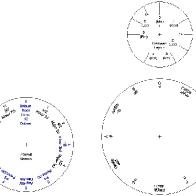Tuning VS Keys, Clearing the air
Many folks seem to equate tuning and key. They are NOT the same, or even equivalent.
Note:This post is based on no extra frets. Extra frets can be considered fretboard overlays or additional fretboards.
A key is a specific series of notes arranged by a specific series steps/half steps and is restricted [or applies] to ONE string, eg., D-E-F#-G-A-B-C#-D = the key of 'D'.
A TUNING is the combination of the OPEN notes of multiple strings and usually consists of a root [bass], 5th [middle], and then a fourth or duplicate middle [melody] of the notes in an 8 note key eg., DAdd/DAAA. Other combinations can also be used, eg., DF#A [a 'D' tuning] . The melody string can be tuned to another note to achieve a different MODAL sound, eg., DACC for aeloian mode, a minor. The bass note, modified by the melody, is used to describe the tuning, but not the key of the tune to be played. This is why DAdd/DAAA/DAAC, etc, are described as 'D' tunings.
Because of the way the MD fretboards are designed, the Ionian step/halfstep spacing, which is also used to define a 'key', starts on the 3rd fret. This means the open tuning of a single string IS NOT the 'key' the string is tuned to, 'key' being used to describe the notes available on that string. EG., tuning the base string to 'D' [open] results in a 'key' of 'G' at the 3rd fret.
When you are tuned to DAdd, you cannot play the 'D' scale [notes of the key], in any order, without having a 6+ [6 1/2 or any '+' notes] on any single string, there is no 'C#' on the melody/bass strings and no 'G' on the middle string. You can only play the key of 'G' notes. To play a 'D' scale you will be in DAAA tuning. This applies to N/D players, C/M players will be able to work something out by using two strings.
So, what does all this boil down to? Tunings are the open notes of the strings. Keys are the notes available starting at the 3rd fret. Other than that, not a whole lot as long as you understand TUNINGS and KEYS are different entities. Having all of the strings tuned [open/unfretted] to a particular set of notes does not allow you to play music with that tuning name without extra frets. Eg., DDD is a 'D' tuning. If a 'D' tune has a 'C#'? Not going to happen, without bending the 6, accurately, 'C#' is 6+.
For N/D players, the only key you will have notes for on the melody string is defined by the key 'name' of the note on the 3rd fret or, in other words; in DAdd only 'G' tunes [no 6+], include 'D' with 6+; in DAAA only 'D'. C/M players may have a bit more flexibility, especially in DAdd.

